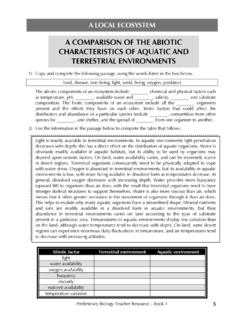Transcription of Terrestrial and Aquatic Environmental Toxicology ©2008 ...
1 Received: 9 July, 2008. Accepted: 15 October, 2008. Original Research PaperTerrestrial and Aquatic Environmental Toxicology 2008 Global Science Books Empirical Modelling of Dissolved Oxygen against Pollution Parameters in Coastal Water in Different Seasons Foluso Oyedotun Agunbiade1* Bamidele Iromidayo Olu-Owolabi2 Kayode Oyebode Adebowale2 1 Department of Chemical Sciences, College of Natural and Applied Sciences, Bells University of Technology, Ota, Ogun State.
2 Nigeria 2 Department of Chemistry, Faculty of Science, University of Ibadan, Ibadan, Nigeria Corresponding author: * ABSTRACT An empirical modelling study of dissolved oxygen (DO) against six pollution parameters: biochemical oxygen demand (BOD), chemical oxygen demand (COD), nitrate, total phosphate, total solids and temperature, analysed from field samples was carried out for wet and dry seasons of April 2006 January 2007. Modelled equations were developed from each parameter using regression analysis to predict DO within the two seasons; the best fitted equation was reported in each case with their corresponding R2 values and the validity ranges evaluated for model calibration.
3 The resulting DO values predicted from the modelled equations were validated by comparison with field data and found to correlate better in the dry season for data obtained based on BOD, COD, nitrate and phosphate. Also, the validity ranges of the models developed from these anthropogenic pollution parameters were wider during the dry season. However, total solids (TS) and temperature used to measure contributions from physical and natural conditions to DO modelling depicts a better simulation during the wet season for the TS prediction due to an increase in natural effects witnessed in the wet season than the dry one.
4 Temperature had the lowest R2 values due to reduced natural temperature variations in the tropical region. Thus, the predictions of DO based on anthropogenic, abstracting pollution parameters are better done in the dry season. _____ Keywords: anthropogenic activities, regression analysis, simulation, wet and dry seasons INTRODUCTION Oxygen dissolved in the Aquatic habitat is indispensable to fish and other living organisms in the zone. The survival of these important Aquatic resources depends on the availa-bility of dissolved oxygen (DO) for their metabolic activi-ties.
5 Fish require the highest level of DO while inverteb-rates require lower and bacteria the least. DO is an important water quality parameter needed for Aquatic life support is however affected by a number of phy-sical conditions (James 2002) and pollutants from anthropo-genic activities (de Bashan and Bashan 2004; Kotti et al. 2005). Light penetration is needed for photosynthesis by phytoplankton and other sea plants to produce oxygen; tidal waves and currents affect the dissolution rate of atmosphe-ric oxygen in the water system by its turbulent mixture while temperature increase of the water system inversely affects DO content (Deas and Lowney 2000).
6 These are among the physical conditions that affect dissolution of oxygen in the water system of coastal areas. These physical conditions vary spatially, temporally and seasonally and their conside-ration helps to understand the state of DO in a zone. Further, disposal of sewage into water bodies, agricultu-ral practices ( the use of fertilizers) and other anthropo-genic activities introduce organic matter and nutrients (ni-trate and phosphate) into the water system. The introduction of these nutrients aid the growth of algae and seed weeds (eutrophication) which in turn increase the organic matter content of the water.
7 The decomposition of organic matter from the disposed sewage and the dead algae is done by ae-robic metabolism of micro-organisms which feed on the bio-mass through an oxidative process using up the dissolved oxygen as oxidant. Thus, DO which should support Aquatic life, is removed by adverse anthropogenic activities. Therefore, DO is an important empirical standard for evaluating water pollution and the quality of water bodies and the support of such for Aquatic life. DO content must then be maintained in such a way that it does not go below a certain desirable minimum concentration.
8 To therefore ana-lyse for and ensure this concentration, modelling of DO in relation to parameters affecting it will be a useful and impe-rative tool. This will assist in planning, managing, formula-tion of policies and monitoring activities that will conserve the environment. There are very limited works in the literature on model-ling of DO (Altunkaynak et al. 2005; Yuan et al. 2007) in coastal waters while much emphasis has been laid on other water quality parameters ( metals and organic micro-pollutants).
9 Likewise, deterministic approaches were adop-ted in most of the models that exist (Park and Lee 2002; Suh et al. 2004; Ghosh and Mujumdar 2006). However, a recent trend in modelling reveals that it is nearly impossible to totally understand the boundaries and the forces guiding the behaviour of a parameter as needed in a deterministic or mechanistic model especially in coastal waters (BDMF 2000; James 2002). Also, the complexity of a model does not imply accuracy since much of the assumptions made in its formulation can cause significant deviation.
10 Thus, an empirical understanding of the pattern of a water quality parameter like DO is necessary in relation to other parame-ters that influence it based on observed field data. This is increasingly becoming as important as the deterministic ap-proach. Therefore, this study presents an empirical modelling of DO in relation to other pollution indicators that affect it. Pollution parameters considered were biochemical oxygen demand (BOD) and chemical oxygen demand (COD), ni-trate-nitrogen, total phosphate, total solids and temperature.














